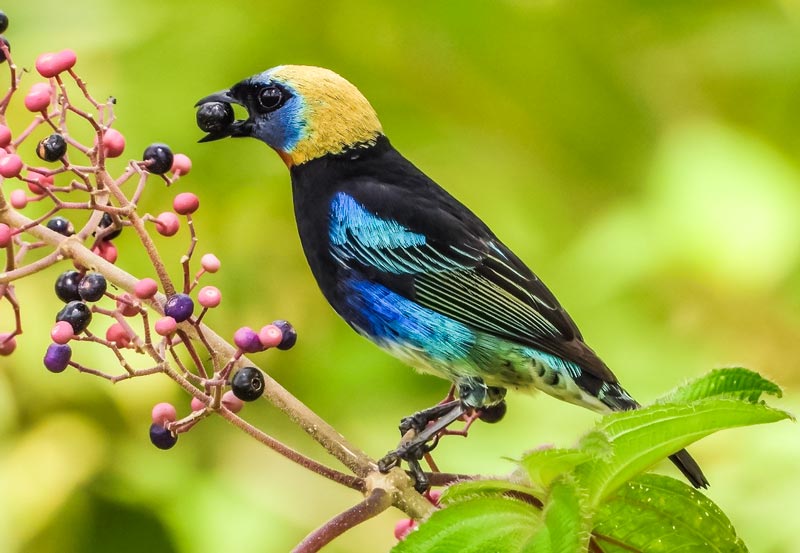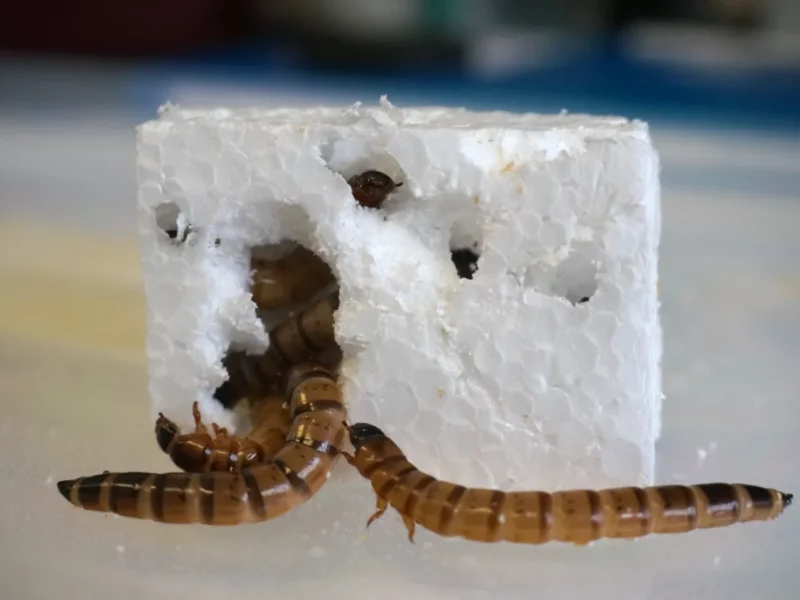1. Nicobar Pigeon

The Nicobar pigeon (Caloenas nicobarica) is the largest living pigeon in the world. It is the closest living relative to the now extinct dodo bird who belong to the same family. This bird is named after one of the places they live in, which is the Nicobar Islands — an island chain in the Indian Ocean. They can also be found in the Malay Archipelago, Palau and a few other spots in Southeast Asia.
The Nicobar pigeon is bigger than the average city pigeon. It’s about 40 centimeters long, weighs about half a kilogram and its wings span over 50 centimeters. The most eye-catching part of the Nicobar pigeon’s appearance are the long iridescent feathers. The Nicobar pigeon has a grey head, big eyes and a distinct white tail. Its long neck features beautiful green and copper hackles.
2. Shining-green Hummingbird
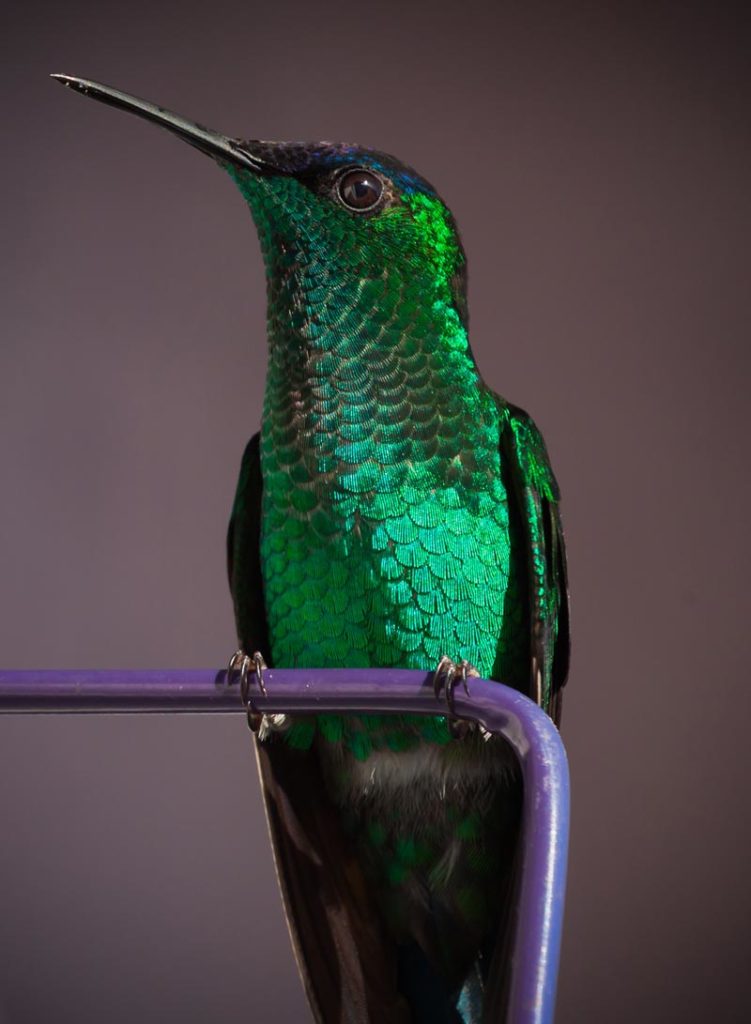
The Shining-green hummingbird (Chrysuronia goudoti) is a species of hummingbird that is found in Colombia and Venezuela. It thrives in subtropical or tropical dry forest, subtropical or tropical dry shrub land, and heavily degraded former forest. Most of their plumage is an iridescent green with darkish wings and tail. It has white leg puffs with a long and slightly down-curved bill.
3. Victoria Crowned Pigeon

The Victoria crowned pigeon (Goura victoria) is a enormous, bluish-grey pigeon with elegant blue lace-like crests, maroon breast and red irises. It is part of a genus (Goura) of four unique, very large, ground-dwelling pigeons native to the New Guinea region. The bird may be easily differentiated from other crowned pigeons by the unique white tips on its crests and by the deep ‘whooping’ or hooting sounds that it makes while calling. Its name commemorates the British monarch Queen Victoria.
4. Scarlet Ibis

Out of the other 27 extant species of Ibis, the Scarlet ibis is unmistakable for its beautiful brilliant orange-red coloration with black wingtips. Breeding adults have black bills, pink at other times. Immatures are dark above with white bellies and pink bills. Its natural habitat are among mangroves and muddy estuaries in tropical South America and part of the Caribbean.
5. Long-tailed Broadbill
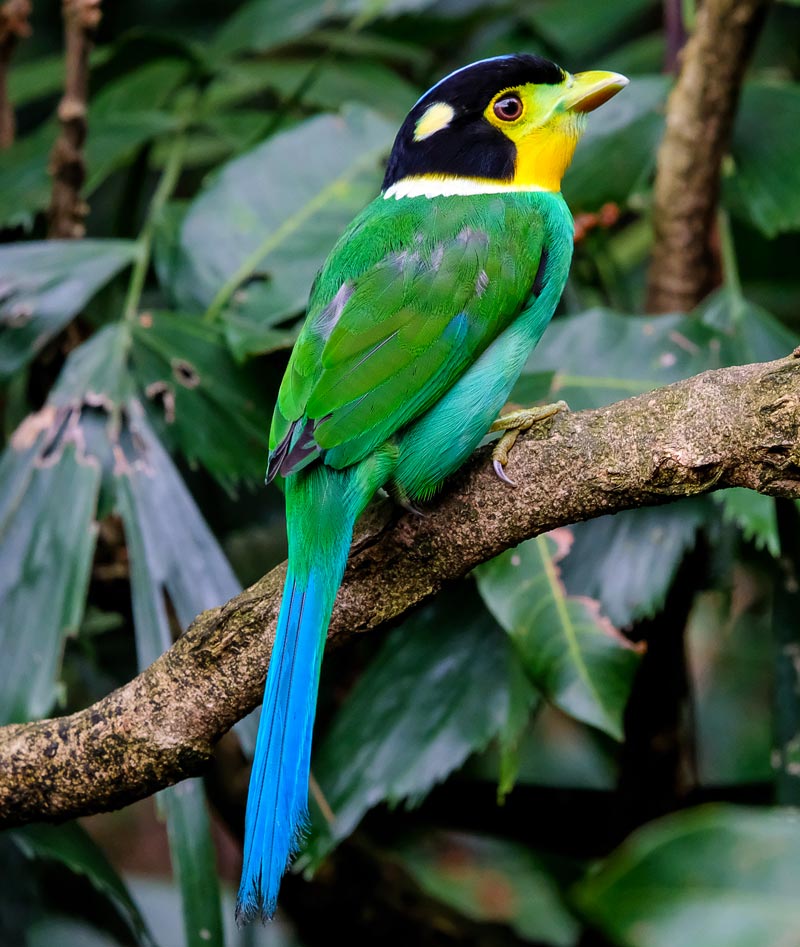
The long-tailed broadbill (Psarisomus dalhousiae) is a species of forest bird that lives in the Himalayas, extending through Northeastern India to Southeast Asia. The long-tailed broadbill measures about 25 cm (10 inches) and weighs between 50 and 60 grams. It has a distinct yellow plumage on the throat and a characteristic shrill call by which it is identified.
It feeds on insects like grasshoppers, flies, bugs, beetles and sometimes also small frogs and berries. They are very sociable and. travel in large noisy flocks, except when they are mating. They build pear-shaped nests from the branches of tall trees where the females lay five to six eggs that are incubated by both sexes; both sexes also help to feed the young.
6. Gouldian finch
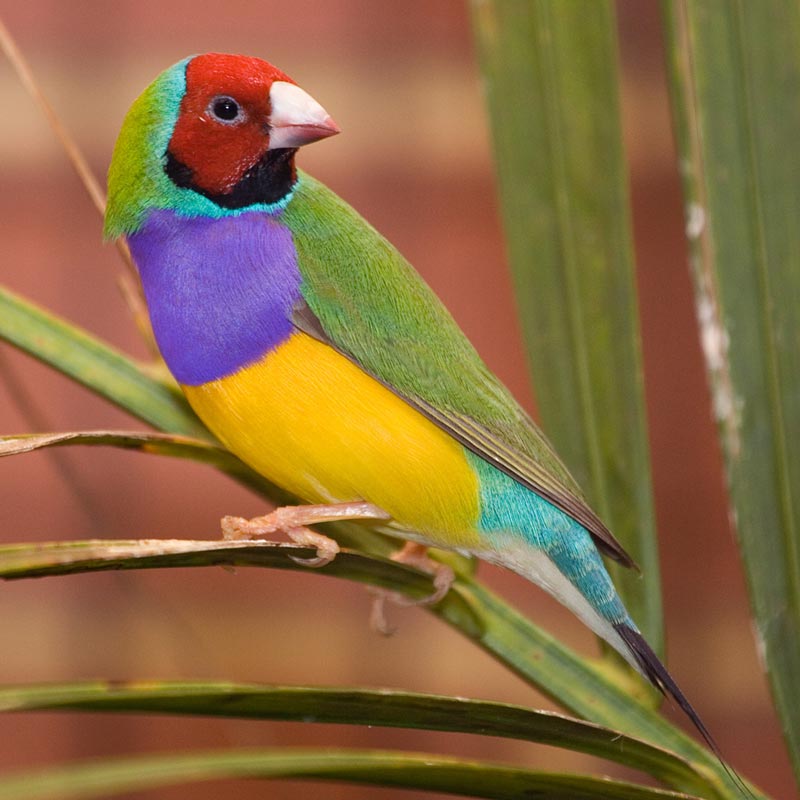
The Gouldian finch (Chloebia gouldiae), also known as the Lady Gouldian finch, Gould’s finch or the Rainbow finch, is a colourful bird that is native to Australia.
Both males and females are brightly coloured with black, green, yellow, and red plummage. The females tend to be less brightly coloured with their chest being a lighter mauve compared to the male whose chest is purple. Gouldian finches are small birds measuring about 125–140 mm long.
7. Violet-backed Starling
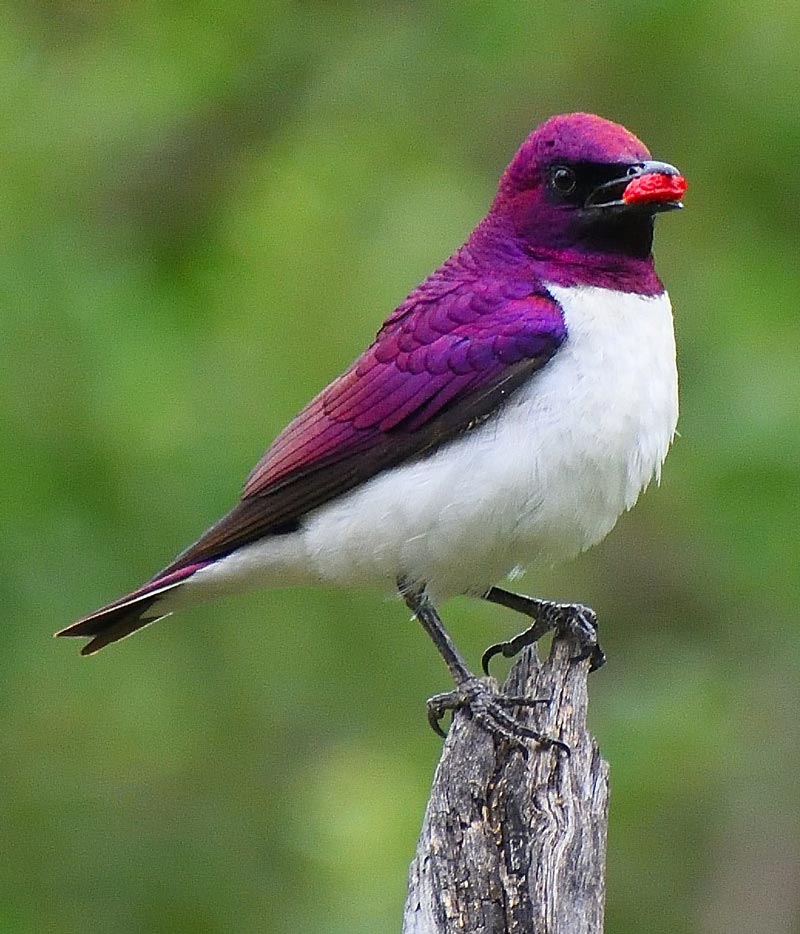
The Violet-backed starling (Cinnyricinclus leucogaster), also known as the plum-coloured starling or amethyst starling, is a relatively small bird measuring about 17 cm. This species is strongly sexually dimorphic, differing in plumage colour and pattern, with the male having an iridescent violet head and back and pure white underparts, while the female has a subdued appearance with streaked brown and white. Both sexes have yellow irises and black bills and legs. The Violet-backed starling lives in the woodlands and savannah forest edges of mainland sub-Saharan Africa. It is rarely seen on the ground, but instead found in trees and perched away from the ground.
8. Mandarin Duck
The mandarin duck (Aix galericulata) is a medium-sized exotic-looking duck species, that tend to perch high in trees, native to the East Asia. It measures 41–49 cm (16–19 in) long with a 65–75 cm (26–30 in) wingspan. It is a close relative to the North American wood duck. ‘Outside of its native range, the mandarin duck has a large extablished population in the British Isles and Western Europe, and smaller in numbers in North America.
The male and female mandarin duck differ in colour and appearance. The male is very ornate with big orangey “sail fins” on the back, streaked reddish cheeks with “whiskers”, and a small red bill with a whitish tip. The female has narrow white eye-ring and stripe running back from the eye. She has a paler plumage on the underside small white flank stripe, and a pale tip to its bill. They flock together mostly in pairs or singly, but will gather in larger flocks over the winter; perches readily in trees over water. Native to East Asia, but has established feral populations throughout Western Europe.
Like many other species of ducks, the male undergoes a moult, or eclipses its plumage, after the mating season. When in eclipse plumage, the male looks similar to the female, but is still distinct from the female by its bright yellow-orange or red beak, absence of a crest, and a more subtle eye-stripe. In the video above you can see male and female mandarin ducks wandering about.
9. Rainbow Lorekeet
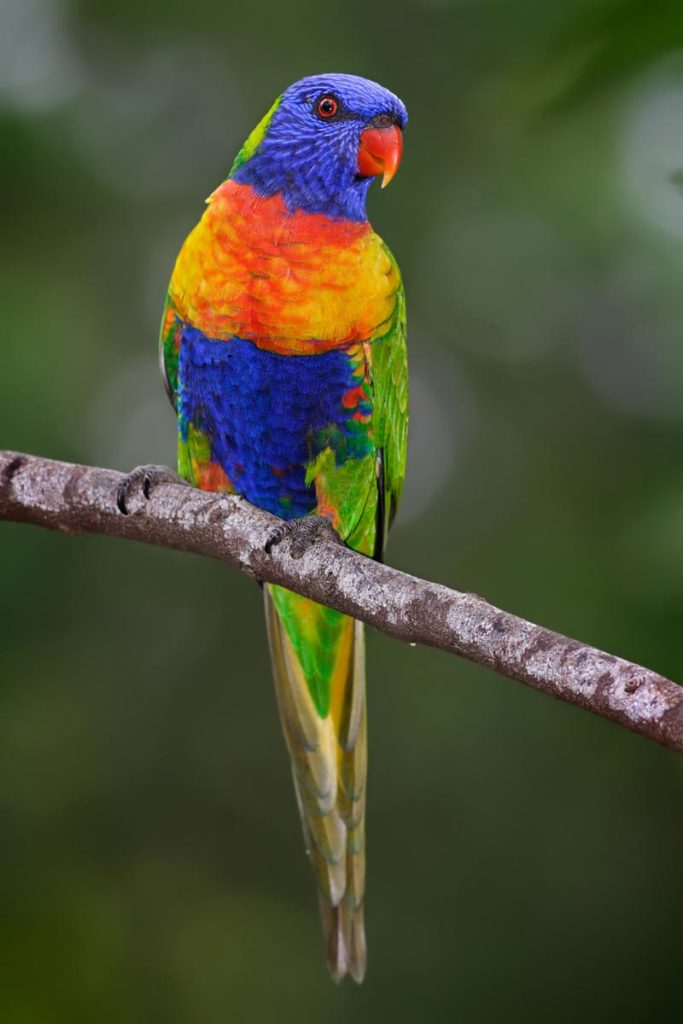
The Rainbow lorikeet (Trichoglossus moluccanus) is a remarkably attractive species of parrot with its bright red beak and multicoloured plumage. It is native to Australian rainforests, coastal bushes and woodland areas, commonly found from Northern Queensland to South Australia. Both sexes look alike, with a blue (mauve) head and belly, green wings, tail and back, and an orange/yellow breast. They often flock together swiftly and can be quite loud.
10. Temminck’s Tragopan

The Temminck’s tragopan (Tragopan temminckii) is a medium-sized, approximately 64 cm long, ornamental pheasant which lives at high altitudes in the Eastern Himalayas, Central China, Southern Tibet, Myanmar and some surrounding areas. The male (pictured) is equisitely coloured with a stocky red-and-orange with white-spotted plumage, black bill and pink legs. It has bare electric blue facial skin, inflatable dark-blue lappet or bib and horns. The females are less conspicuous with white-spotted brown plumage and blue circular eye skin.
This pheasant’s diet consists mainly of berries, grass and plants. In general the Temminck’s tragopan is quiet except during courting when males make loud booming moans.
11. Crimson Sunbird
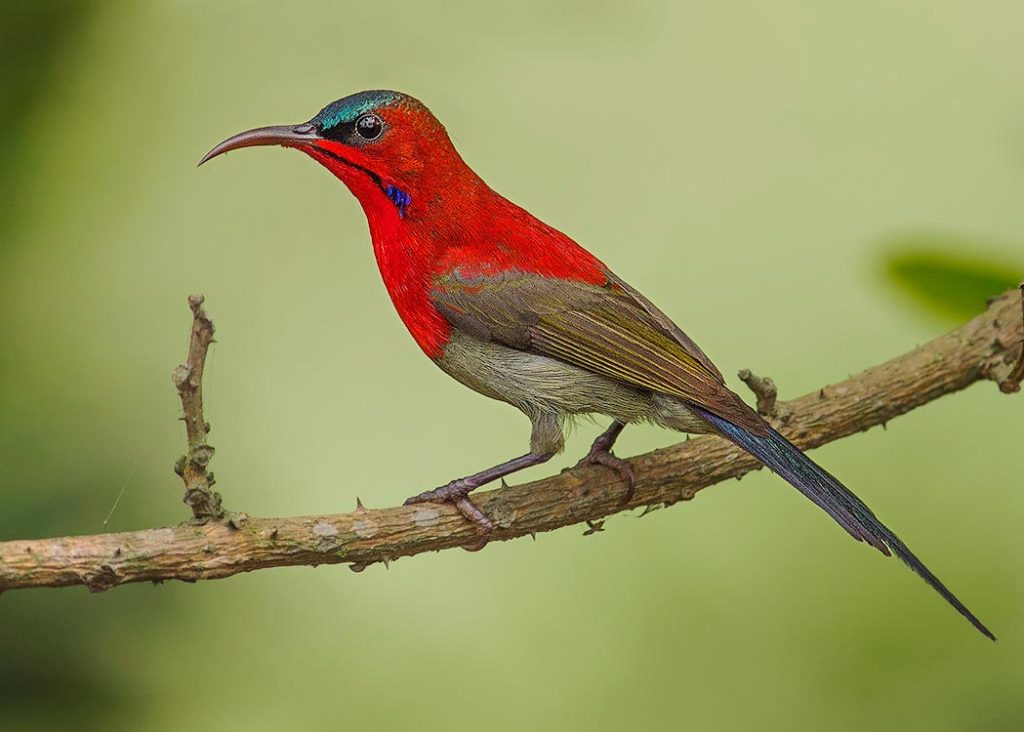
The crimson sunbird (Aethopyga siparaja) is a species of tiny bird, only 11 cm long, in the sunbird family which feed largely on nectar. They may also eat insects, especially when feeding their young. With their wings being short, they fly fast on a direct path. Most species can take nectar by hovering like a hummingbird, but usually perch to feed.
Their bills are of medium-length, thin and down-curved, and they have brush-tipped tubular tongues; both are adapted for their nectar feeding. The adult male has a crimson breast and maroon back. The rump is yellow and the belly is olive. The female has an olive-green back, yellowish breast and white tips to the outer tail feathers. Their call is chee-cheewee.
12. European Bee-eater (Merops apiaster)
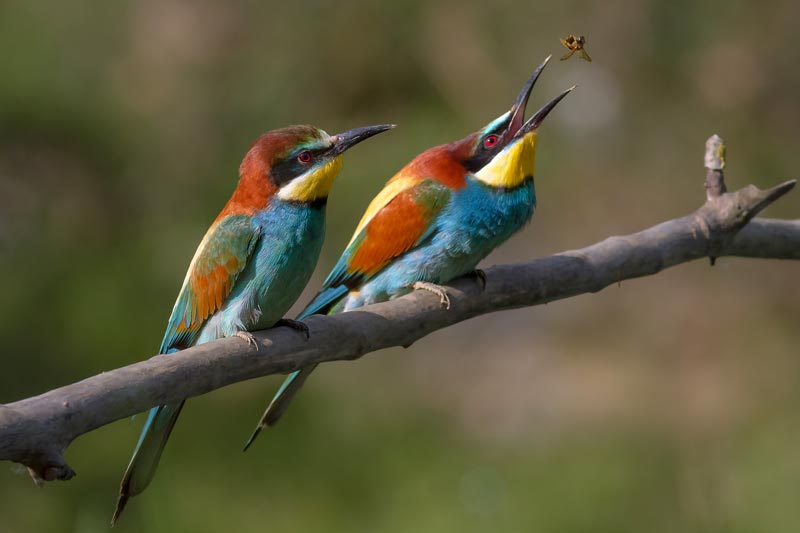
The European bee-eater (Merops apiaster) is a migratory bird that breeds in southern and central Europe, northern and southern Africa, and western Asia. Except for the resident southern African population, the species migrate to tropical Africa during the winter.
It is impressively colorful and has a distinct long bill to catch insects. It has bright yellow throat, gemstone-blue belly, and flame-colored back. It usually resides in the countryside, mainly in drier areas, sand banks and often river banks. It feeds by catching insects (especially bees) on the wing. It often gives distinctive pipping calls.
13. Common Kingfisher

The common Kingfisher (Alcedo atthis), also known as the Eurasian kingfisher and river kingfisher, is a beautiful small blue-and-orange bird with a long, pointed bill, typically short-tailed and large-headed. It resides along rivers, streams, lakes, and ponds or habitats with small fish, as it feeds mainly on fish, caught by diving, and has special visual adaptations to enable it to see its prey under water.
It is distributed widely across Eurasia and North Africa, but migrates during winter from areas where the rivers freeze. This common Kingfisher is a rather shy bird and generally remains hidden. Although, it is easily detected by its high, shrill whistled call.
14. Golden-hooded tanager
The Golden-hooded tanager (Stilpnia larvata) is a medium-sized attractive tanager residing in humid tropical forests, plantations and gardens of southern Mexico south extending to western Ecuador. They are often found in pairs and feed on small fruits and sometimes insects.
Adult Golden-hooded tanagers are about 13 cm (5.1 in) long and weigh 19 g (0.67 oz). Both the males and females are quite similar in colour and appearance, being black and blue overall with white underparts and golden head. Females tend to have a greenish tinge to the head and more widespread white underparts. The youngs are duller, with a green head and dark grey underparts, and little blue in the plumage.
The golden-hooded tanager’s makes a sharp tsit call and the song is a tuneless rattled series of tick sounds.
15. Echo Parakeet

The Echo parakeet (Psittacula eques), sometimes known as the Mauritius parakeet, is a species of parrot endemic to the Mascarene Islands of Mauritius and formerly Réunion. It is the only living native parrot of the Mascarene Islands; all others have become extinct due to human activity.
The Echo parakeet is 34–42 cm (13–17 in) long, weighs 167–193 g (5.9–6.8 oz), and its wingspan is 49–54 cm (19–21 in). Male and female are very similar in appearance with slight differences in colour. It is generally green (the female is darker overall) and has two collars on the neck; the male has one black and one pink collar, and the female has one green and one indistinct black collar. The upper bill of the male is red and the lower blackish brown; the female’s upper bill is black. The skin around the eyes is orange and the feet are grey. The echo parakeet has a wide range of vocalisations, the most common sounding like “chaa-chaa, chaa-chaa”.
16. Common Starling
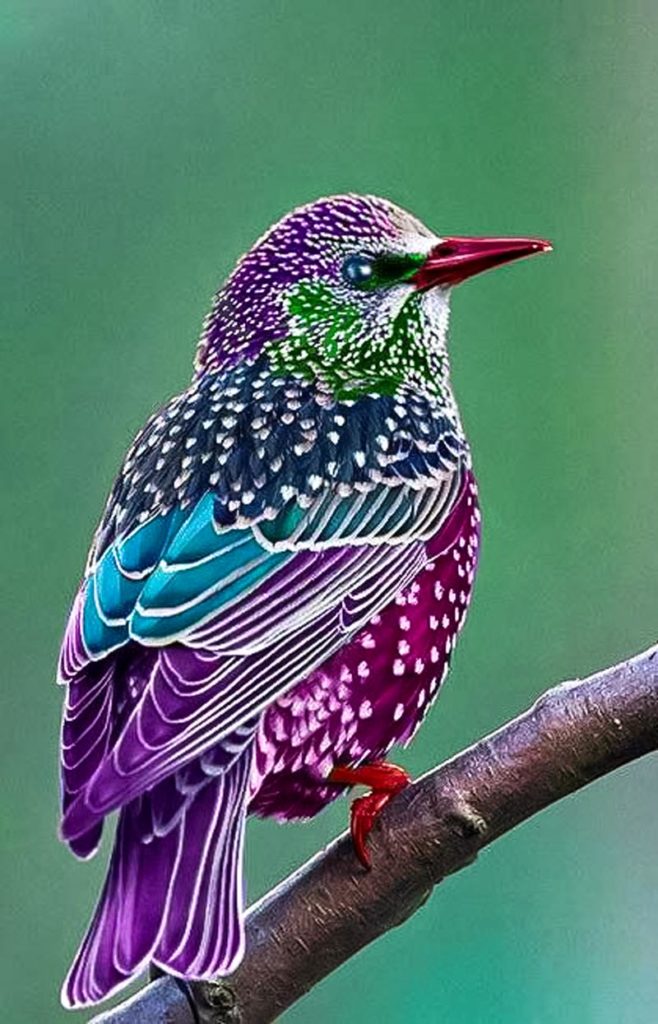
The Common starling or European starling (Sturnus vulgaris), also known simply as the starling in Great Britain and Ireland, is a medium-sized passerine bird of about 20 cm (8 in) long. It is very attractive with a glossy black plumage that has a metallic sheen; it is speckled with white at some times of year. The legs are pink and the bill is black in winter and yellow in summer; young birds have browner plumage than the adults. It is a noisy bird, with an unmusical but varied song.
17. Rose Robin
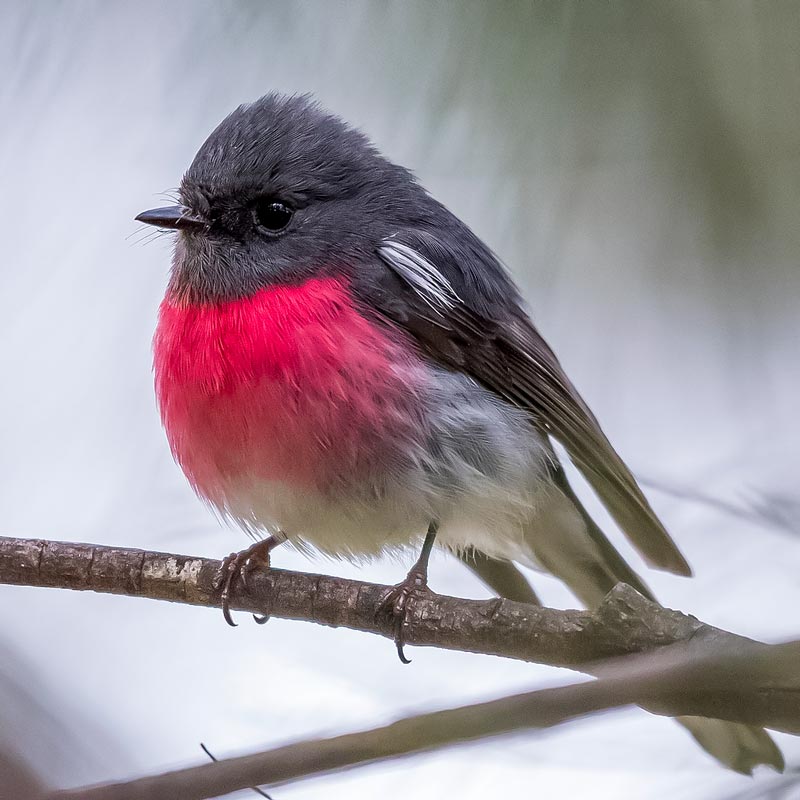
The Rose robin (Petroica rosea) is a small passerine bird native to Australia. Like many brightly coloured robins of the Petroicidae, it is sexually dimorphic. The male has a distinctive pink breast. Its upperparts are dark grey with white frons, and its tail black with white tips. The underparts and shoulder are white. The female is an undistinguished grey-brown. The robin has a small black bill and eyes.
Its natural habitats are temperate forests and subtropical or tropical lowland rainforests, during spring and summer. It usually moved into drier, more open habitats during autumn and winter.
18. Little Blue Heron
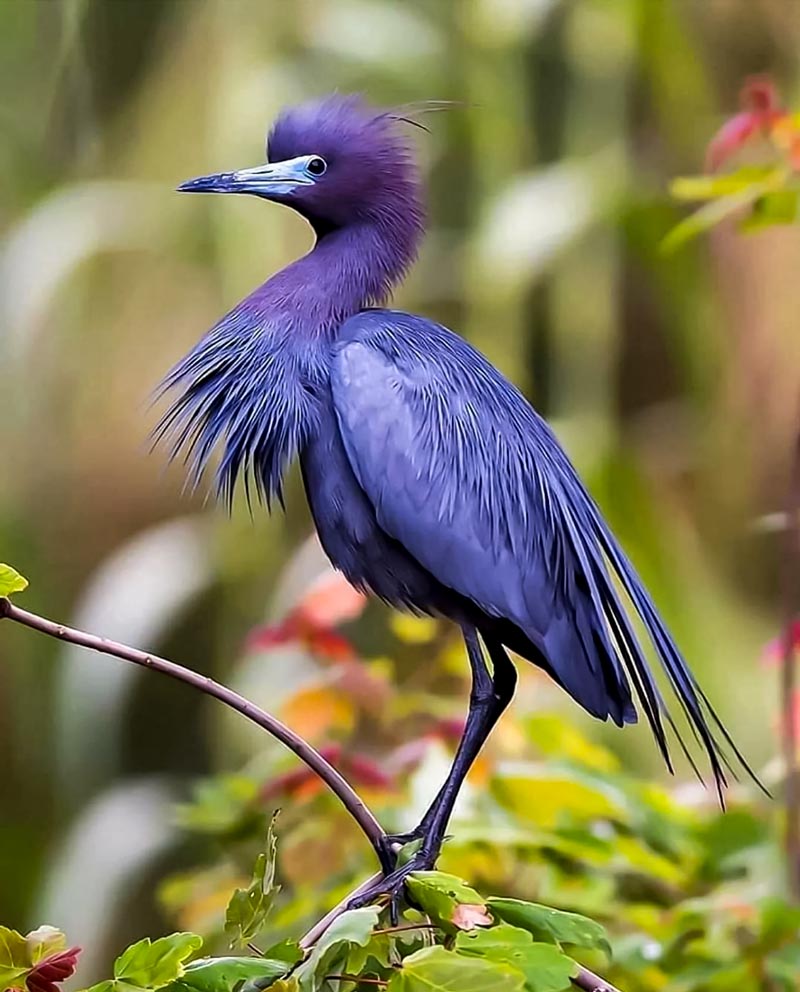
The Little Blue heron is a small heron with exceptionally different adult and immature plumages. The adult is mostly grayish-blue with a contrasting deep purplish head and neck, greenish legs and bicolored bill. The juveniles are all white in their first year, with tiny dark tips on the outer wingtips. Not to be confused with the Snowy Egret, Little Blue always has dull greenish legs, grayish or greenish lores, and usually a two-toned bill.
The Little Blues start to show small patches of gray-blue plumage in their first spring. They commonly reside in the eastern U.S. to South America; especially near the coast. They love a variety of wetland habitats, especially shallow marshy pools.
19. Common Flameback
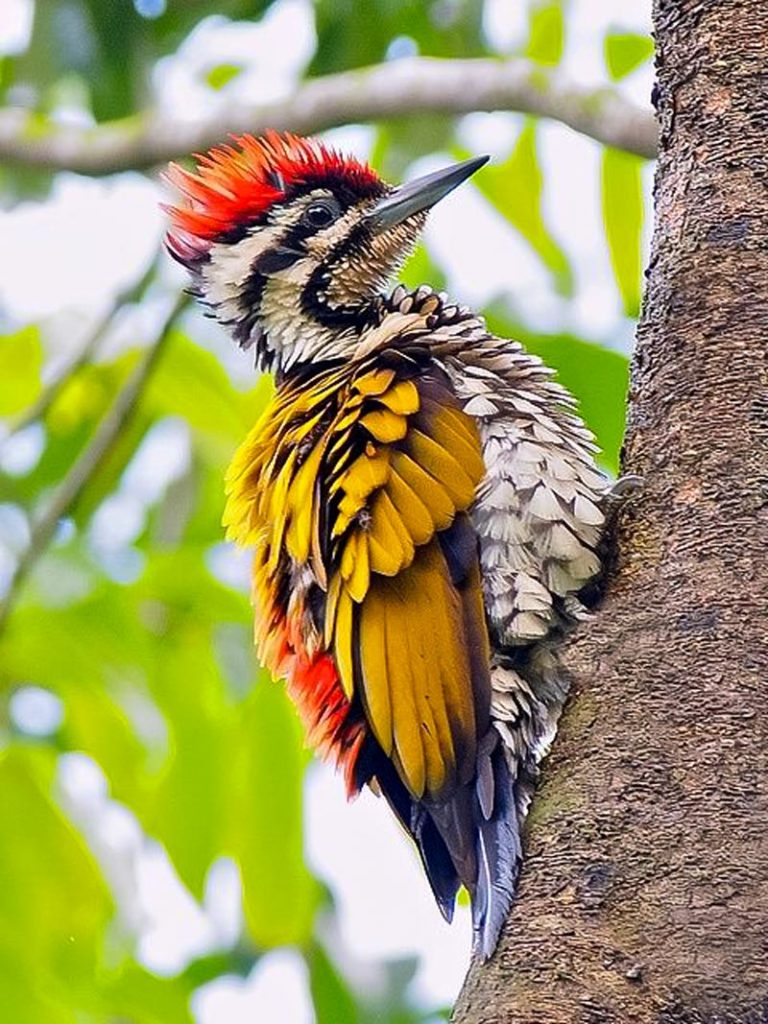
The Common Flameback (Dinopium javanense), also referred to as the Common Goldenback, is a small (28–30 cm), three-toed, small-billed woodpecker, found throughout South and Southeast Asia.
It resided primarily in wet tropical forests. Its much smaller bill, a black nape, and a black undivided horizontal stripe below the cheek, separates it from the Greater Flameback. This woodpecker is often recognised by its loud, high-pitched trill similar to that of Greater Flameback.
20. Red Crusted Turaco
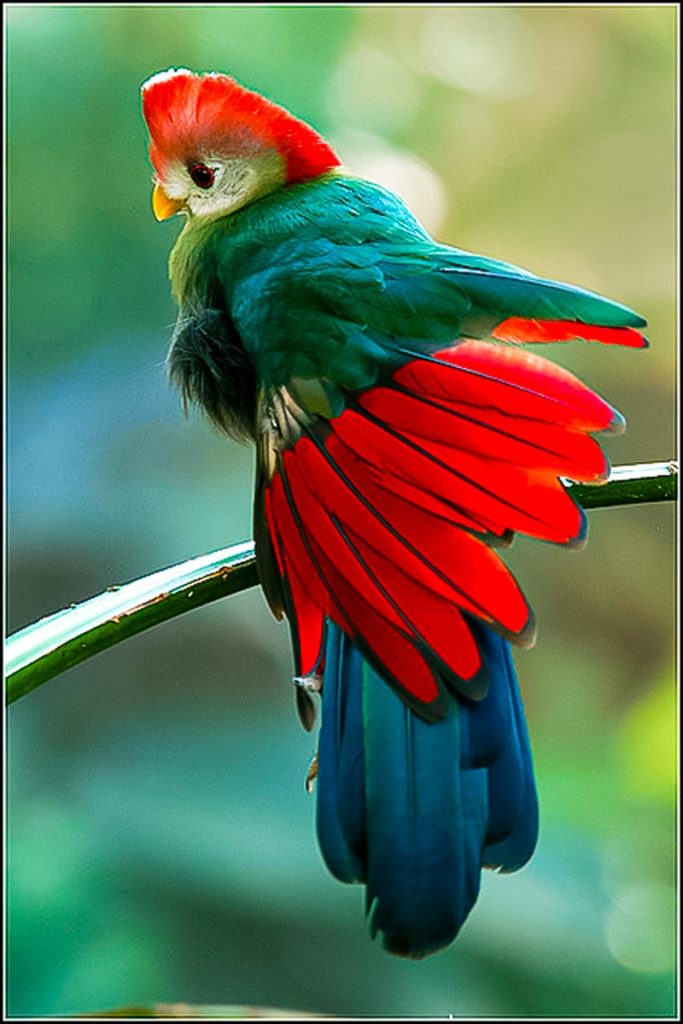
The Red-crested turaco (Tauraco erythrolophus) is an African bird found in the forests and the Miombo woodland, endemic to Angola. It has a long tail, bulky greenish plumage with a yellow bill, a red crest that is sometimes tipped white and a whitish face. When flying, deep red panels are visible in the wings. It makes a particular song lasts about 10 seconds — a whooping “hooooah” followed by 7–10 harsh croaking repeated “khaaar” notes — which sounds like a jungle monkey.

